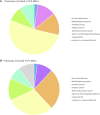Genetic profiling of human bone marrow mesenchymal stromal cells after in vitro expansion in clinical grade human platelet lysate
- PMID: 36324892
- PMCID: PMC9621119
- DOI: 10.3389/fbioe.2022.1008271
Genetic profiling of human bone marrow mesenchymal stromal cells after in vitro expansion in clinical grade human platelet lysate
Abstract
Mesenchymal stromal cells (MSCs) are non-hematopoietic cells that have a broad therapeutic potential. To obtain sufficient cells for clinical application, they must be expanded ex vivo. In the initial expansion protocols described, fetal calf serum (FCS) was used as the reference growth supplement, but more recently different groups started to replace FCS with platelet lysate (PL). We investigated in this study the impact of the culture supplement on gene expression of MSCs. Human bone marrow derived MSCs were expanded in vitro in FCS and PL supplemented medium. We found that MSCs expanded in PL-containing medium (PL-MSCs) express typical MSC immunomorphological features and can migrate, as their counterparts expanded in FCS-containing medium, through a layer of endothelial cells in vitro. Additionally, they show an increased proliferation rate compared to MSCs expanded in FCS medium (FCS-MSCs). RNA sequencing performed for MSCs cultured in both types of expansion medium revealed a large impact of the choice of growth supplement on gene expression: 1974 genes were at least twofold up- or downregulated. We focused on impact of genes involved in apoptosis and senescence. Our data showed that PL-MSCs express more anti-apoptotic genes and FCS-MSCs more pro-apoptotic genes. FCS-MSCs showed upregulation of senescence-related genes after four passages whereas this was rarer in PL-MSCs at the same timepoint. Since PL-MSCs show higher proliferation rates and anti-apoptotic gene expression, they might acquire features that predispose them to malignant transformation. We screened 10 MSC samples expanded in PL-based medium for the presence of tumor-associated genetic variants using a 165 gene panel and detected only 21 different genetic variants. According to our analysis, none of these were established pathogenic mutations. Our data show that differences in culture conditions such as growth supplement have a significant impact on the gene expression profile of MSCs and favor the use of PL over FCS for expansion of MSCs.
Keywords: expansion; gene expression; mesenchymal stromal cell; platelet lysate; transformation.
Copyright © 2022 De Becker, Heestermans, De Brouwer, Bockstaele, Maes and Van Riet.
Conflict of interest statement
The authors declare that the research was conducted in the absence of any commercial or financial relationships that could be construed as a potential conflict of interest.
Figures





Similar articles
-
Optimization of in vitro expansion of human multipotent mesenchymal stromal cells for cell-therapy approaches: further insights in the search for a fetal calf serum substitute.J Cell Physiol. 2007 Apr;211(1):121-30. doi: 10.1002/jcp.20911. J Cell Physiol. 2007. PMID: 17187344
-
GMP-compliant isolation and expansion of bone marrow-derived MSCs in the closed, automated device quantum cell expansion system.Cell Transplant. 2013;22(11):1981-2000. doi: 10.3727/096368912X657990. Epub 2012 Oct 25. Cell Transplant. 2013. PMID: 23107560
-
Autologous Platelet Lysate Does Not Enhance Chondrogenic Differentiation of Equine Bone Marrow-Derived Mesenchymal Stromal Cells Despite Increased TGF-β1 Concentration.Stem Cells Dev. 2020 Feb 1;29(3):144-155. doi: 10.1089/scd.2019.0239. Epub 2020 Jan 6. Stem Cells Dev. 2020. PMID: 31802705
-
Platelet lysate as a substitute for animal serum for the ex-vivo expansion of mesenchymal stem/stromal cells: present and future.Stem Cell Res Ther. 2016 Jul 13;7(1):93. doi: 10.1186/s13287-016-0352-x. Stem Cell Res Ther. 2016. PMID: 27411942 Free PMC article. Review.
-
Use of platelet lysate for bone regeneration - are we ready for clinical translation?World J Stem Cells. 2016 Feb 26;8(2):47-55. doi: 10.4252/wjsc.v8.i2.47. World J Stem Cells. 2016. PMID: 26981170 Free PMC article. Review.
Cited by
-
Human platelet lysate enhances small lipid droplet accumulation of human MSCs through MAPK phosphorylation.Stem Cell Res Ther. 2024 Dec 18;15(1):473. doi: 10.1186/s13287-024-04085-5. Stem Cell Res Ther. 2024. PMID: 39696689 Free PMC article.
-
Engineered Mesenchymal Stem Cells as Treatment for Cancers: Opportunities, Clinical Applications and Challenges.Malays J Med Sci. 2024 Oct;31(5):56-82. doi: 10.21315/mjms2024.31.5.5. Epub 2024 Oct 8. Malays J Med Sci. 2024. PMID: 39416732 Free PMC article. Review.
-
Human platelet lysate produced from leukoreduction filter contents enables sufficient MSC growth.Stem Cell Res Ther. 2025 Apr 23;16(1):205. doi: 10.1186/s13287-025-04329-y. Stem Cell Res Ther. 2025. PMID: 40270024 Free PMC article.
References
LinkOut - more resources
Full Text Sources

